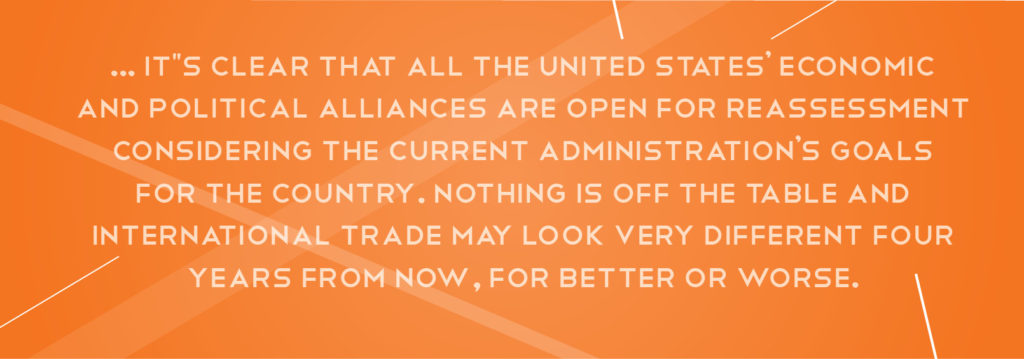The Trans-Pacific Partnership (TPP) is no more. As one of President Trump’s first executive actions, the potential trade deal involving 12 countries (that make up 40% of the world’s GDP) was put to bed.
It’s hard to determine what the United States is gaining or giving up in relation to job retainment and economic growth, as any numbers floating around at this point are disputed and criticized depending on the political party and support of the decision. It can be said that while the TPP was negotiated under former President Obama, it was never actually ratified by Congress – so this withdrawal will not have any immediate home-hitting effects.
What this move does establish is a very different US trade stance than in years past, and one that has experts scratching their heads wondering what’s next.
What is the TPP?
The TPP would have been the biggest trade deal of its kind and spanned the Pacific including a total of 12 countries: Japan, Malaysia, Vietnam, Singapore, Brunei, Australia, New Zealand, Canada, Mexico, Chile and Peru.
According to BBC, “The pact aimed to deepen economic ties between these nations, slashing tariffs and fostering trade to boost growth. Members had also hoped to foster a closer relationship on economic policies and regulation.”
It was a signature effort of the Obama administration and took more than two years to develop. Prior to the election, the deal had bi-partisan support and was set to reshape commerce throughout Asia and the Pacific Rim, but all 12 countries needed to be on-board with the deal before it could be in effect.
Good, bad, or somewhere in-between.
Trump pledged to withdraw from the TPP during his campaign, arguing that is was harmful to American workers and domestic manufacturing. The US hadn’t withdrawn from a trade agreement since the Canadian-American Reciprocity Treaty in 1866! Following through on his promise sent shockwaves throughout Asian capitals, many of which hoped for increased economic growth and prosperity in their home countries following ratification of the deal.
Those in support of the executive action had concerns about how the trade deal would impact American manufacturing and job stability. Labor groups asserted that the TPP would only continue to shift American jobs overseas to nations with lower wages and fewer labor protections.
At the same time, business may lose access to new potential trade markets. For example, CNN reported that automakers hoped to see tariffs reduced in Asia and famers were hoping to see the removal of trade taxes preventing them from selling product overseas. Tech companies were also seeking a way to lessen regulations and reduce barriers to entry in countries that were part of the deal.
While many applaud the move as a long time coming, others are concerned that increasing protectionist policies will undercut our ability to sell to a large consumer base outside the US.
What now?
The 11 remaining nations plan to reorganize and press forward with the TPP, but with the US tapping out, major revisions (and perhaps an alternative agreement with another global stakeholder) will take place.
“The T.P.P. offers very material benefits for all parties that signed up for the agreement,” said Australia’s trade minister, Steven Ciobo. “It would be a great shame to lose those benefits. Notwithstanding President Trump’s decision, there’s still a lot of merits to capturing those gains.”
With NAFTA also slated for a renegotiation soon, it’s clear that all the United States’ economic and political alliances are open for reassessment considering the current administration’s goals for the country. Nothing is off the table and international trade may look very different four years from now, for better or worse.
Sources:
http://www.cnn.com/2017/01/23/politics/trump-tpp-things-to-know/index.html
http://www.bbc.com/news/business-32498715
https://www.nytimes.com/2017/01/23/us/politics/tpp-trump-trade-nafta.html

